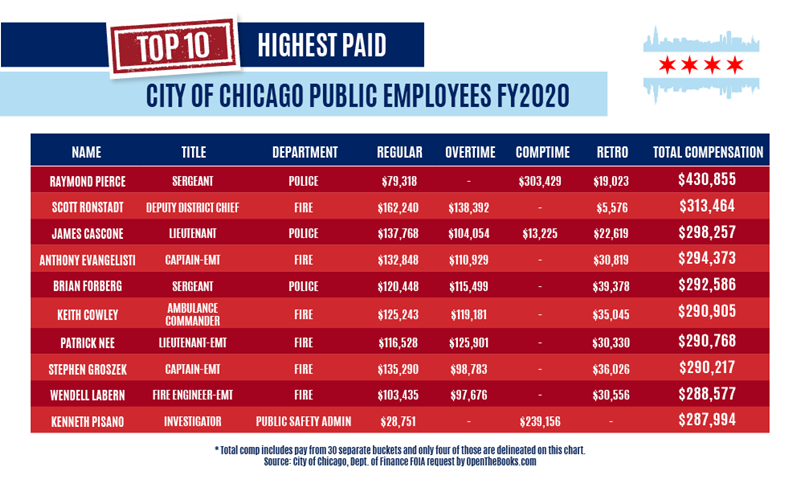



By Adam Andrzejewski
As civil unrest loomed and a pandemic raged last year, Chicago Mayor Lori Lightfoot fully compensated police and other first-responder public safety employees.
However, new payroll data from Freedom of Information Act requests filed by our auditors at OpenTheBooks.com show that the number of regular police officers between 2019 and 2020 dropped by nearly 400 positions.
With fewer officers and more to do, the existing employees made a lot of money—but the city became less safe and, for taxpayers, more expensive.
Nearly 1,000 police and fire employees made between $200,000 and $430,000 during the year. Full-time first responders—including officers, firefighters, sergeants, lieutenants, and others—averaged $122,000. That’s cash compensation alone and does not include the cost of benefits.
Lightfoot poured $626.5 million into overtime, comp time, retroactive pay, fitness pay, duty availability pay, and 29 other compensation avenues for 20,615 employees in the police and fire departments. This was up from $482.3 million in extra pay during 2019.
Chicago’s thin(ner) blue line of highly compensated—although over-worked—public-safety officers held back social anarchy, provided pandemic emergency services, and protected a city of 2.7 million residents.
The city seemed like it was under attack during periods of last summer and fall. Consider these comments made by a Black Lives Matter organizer over the summer:
“I don’t care if someone decides to loot a Gucci or a Macy’s or a Nike store, because that makes sure that person eats,” said Ariel Atkins, according to NBC Chicago. “That makes sure that person has clothes…That is reparations. Anything they wanted to take, they can take it because these businesses have insurance.”
Defunding the police failed under previous mayor Rahm Emanuel. Between 2011 and 2016, the police officer headcount dipped by 1,000. In 2016, shootings in the neighborhoods spiked to 3,500 and homicides peaked at 770 (more than the combined total of New York and Los Angeles) before 1,000 additional officers were added.
However, Lightfoot seems to be working to implement Emanuel’s failed policy. The city recently disclosed that the rank-and-file officer headcount dropped from 12,284 in 2019 to 11,898 in 2020. Those numbers included every cop drawing a paycheck, even those making as little as $133 for the year.
Our auditors at OpenTheBooks.com reviewed Chicago police and fire payrolls from 2020. Here are some highlights:
- We found 3,818 first responders who made more than $150,000, including 350 police officers, sergeants, and lieutenants, and 628 firefighters and paramedics who pulled in more than $200,000.
- Police officers: the top 265 of 11,898 rank-and-file police officers made between $150,000 and $215,500. However, the average officer made $101,000 in 2020.
- Firefighters: the top 68 of 425 regular firefighters earned between $150,000 and $210,534. However, the average firefighter made $94,000.
- Emergency medical technicians (EMT): the top 3,100 earned an average of $147,000. EMT captains did even better with 181 of 194 making between $150,000 and $294,000.
- Ambulance commanders: the top 88 commanders earned an average of $203,000 with pay topping out at a lucrative $290,905.
Top paid police officer Sergeant Raymond Pierce earned $430,854 in his final year before retirement. His base pay was $79,318 with comp time pay at $303,428. Additional pay included retroactive pay ($19,022); baby furlough buy back ($1,884); duty availability pay ($3,484); personal day buy back ($4,651); supervisor’s quarterly overtime ($6,040); uniform allowance ($1,250); and a vacation payout ($11,776).
The top paid fire department employee Deputy District Chief Scott Ronstadt earned $313,463. His base pay was $162,240 with $138,391 in overtime pay; $5,576 in retroactive pay; $2,106 for continuing education; $3,650 for duty availability; and $1,500 for uniform allowance.
Critics say that the mayor has plenty of options to ensure public safety, but has misallocated resources.
In a recent piece for the Chicago Tribune, columnist John Kass critiqued Mayor Lightfoot: “The people of Chicago want two things from their mayor: They want to be safe, and they want their kids in school. She has struggled to provide either.”
Kass argued that Lightfoot didn’t effectively stop downtown looting or help reopen businesses and public schools (Catholic schools opened in September 2020 for in-classroom instruction).
Congress provided $1.8 billion to bail out the city budget as part of the American Rescue Plan Act. So, the mayor has a fiduciary responsibility to the country as well as her local constituents.
If residents feel that the streets are less safe, there’s a reason. The Sun-Times reportedthat in the first four months of 2021, Chicago police reported 997 shooting victims and 187 murders, compared to 718 victims and 156 murders during the same period in 2020.
Chicagoans, and every U.S. taxpayer, have good reason to question why $630 million in overtime and extra pay to first responders didn’t create a safer city in 2020… or a city that worked.
Note: We reached out to Mayor Lori Lightfoot for comment and will update the piece with any response.